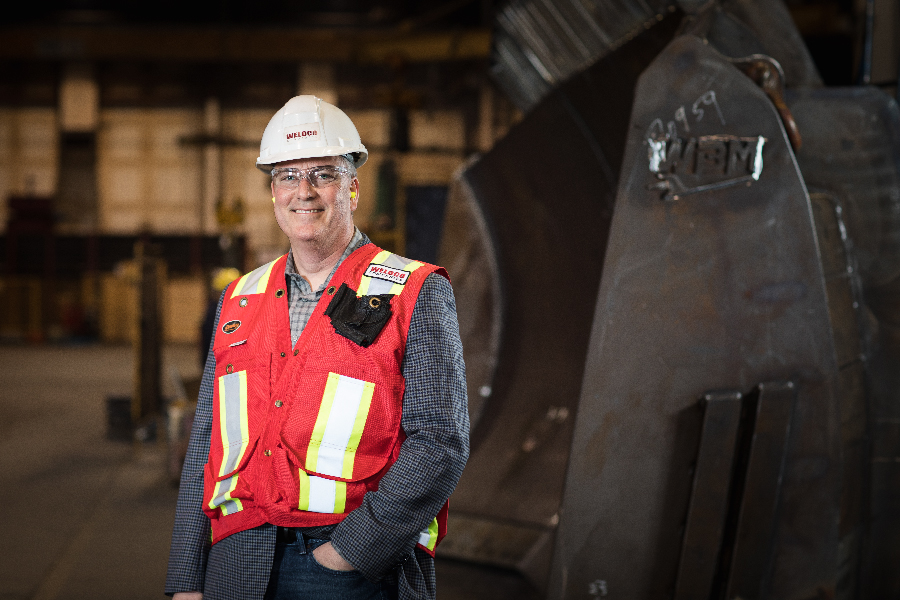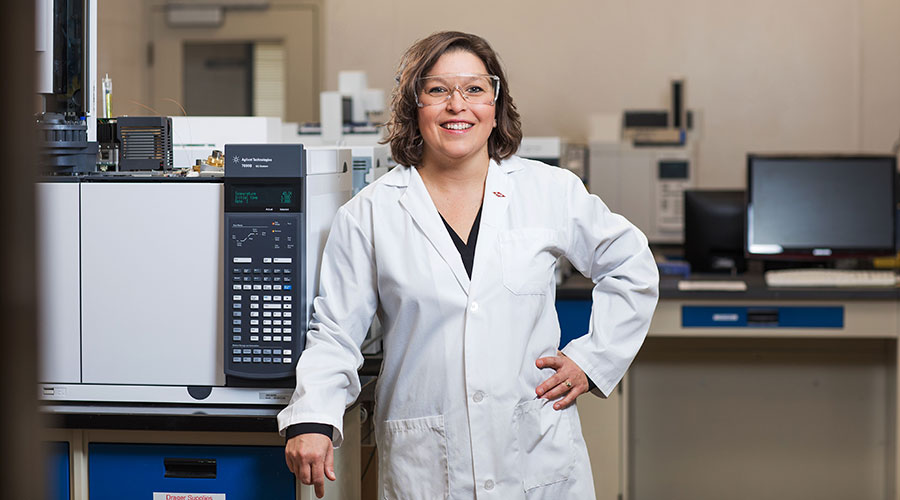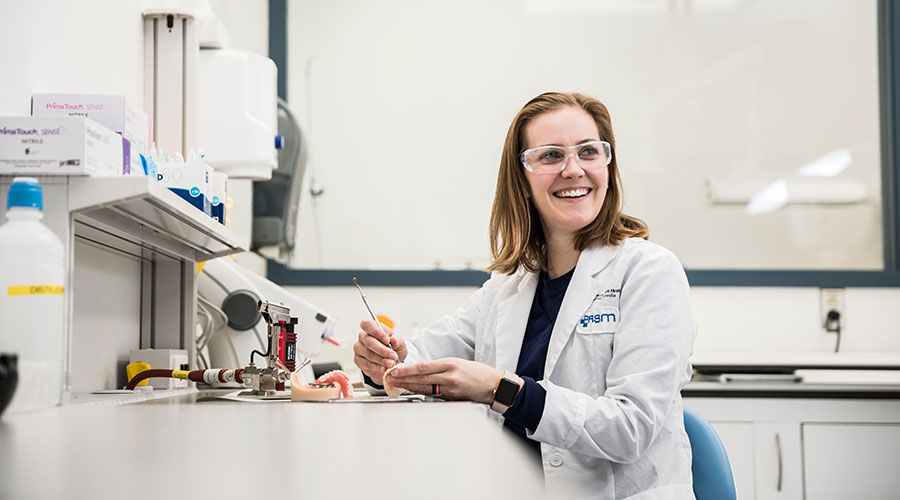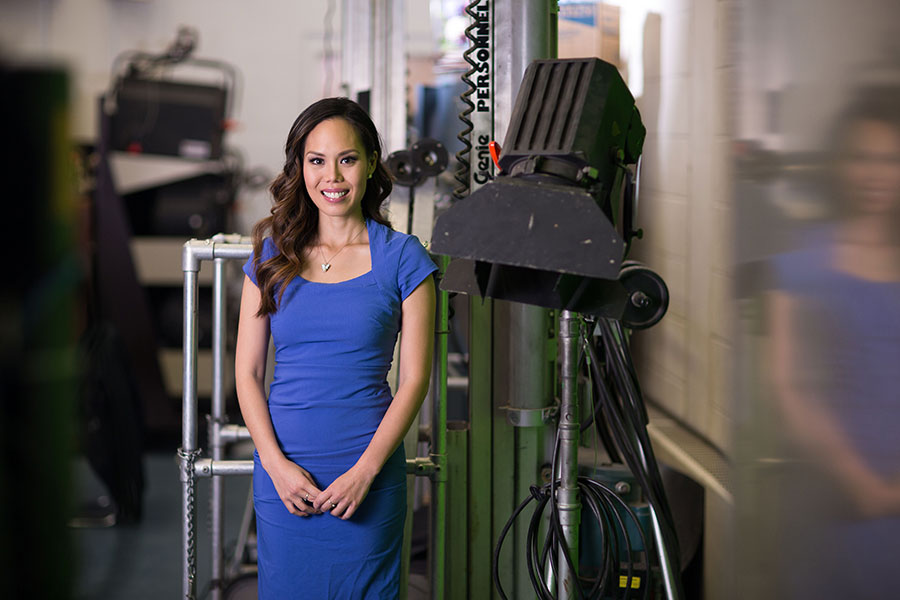Impact of grads' work felt by Alberta and NAIT alike
This is no easy task. Each year, NAIT recognizes the outstanding contributions of our alumni community and bestows awards to some of our best and brightest.
Four talented grads earned 2018 Alumni Recognition Awards and represented a variety of sectors, from broadcasting and science to manufacturing and health care. Learn more about each – and don't forget to nominate outstanding alumni for the 2019 awards (deadline is Nov. 15).
From steel to stellar: captain of industry forges partnership with alma mater
Darren Lunt (Marketing ’90) – Alumni Award of Distinction
President, Weldco Companies
 Manufacturing isn’t the first industry to come to mind when considering the Alberta economy. For decades, it’s been a sliver of the pie that is the provincial GDP – less than seven per cent at last count others.
Manufacturing isn’t the first industry to come to mind when considering the Alberta economy. For decades, it’s been a sliver of the pie that is the provincial GDP – less than seven per cent at last count others.
As president of Weldco-Beales Manufacturing, Darren Lunt knows what it means to operate in that overshadowed sector. It’s a place of innovation occupied by creative people eager to serve Alberta industries. Still, he understands why it tends to be unsung.
“People are surprised that our core input is flat steel,” he says, “and that what comes out the other end looks a lot different.”
The Edmonton-based operation has 425 staff members who design, manufacture and sell heavy equipment attachments for construction, forestry, mining and other industries across the continent and beyond. “Anything that goes on the end of a piece of heavy equipment – whether it be a bucket, blade, grapple – we would probably have a part in it,” says Lunt.
The company sees revenues upwards of $100 million a year. And, right now, it’s struggling with a labour shortage. Since joining Weldco-Beales (initially as head of marketing) in 2005, Lunt has looked to his alma mater to help solve that problem.
“I wish there were more NAITs in Canada,” he says. “It doesn't help Alberta if we get busy and have to start outsourcing [staff] from other regions. We want homegrown solutions.”
But Lunt doesn’t just wait for NAIT to deliver. He gets involved.
Every year for nearly a decade, the alum has provided Marketing and Management students at the JR Shaw School of Business with “live cases” – projects that address real challenges that industry (Weldco-Beales, in this case) needs to solve.
“It’s not the closest they can get to the real world – it is real world,” says instructor Keven McGhan (Finance ’89), who says Lunt took a two-day course at NAIT on how to write the cases. Lunt also sits on NAIT program advisory committees, and, through Weldco-Beales, finances student scholarships.
McGhan knows that Lunt’s motivation stems in part from the needs of his company. But, “Darren’s the kind of guy who gives without worrying about what he gets back.”
“Darren’s the kind of guy who gives without worrying about what he gets back.”
Lunt enjoys contributing to his “partnership” with NAIT. He also enjoys being able to give students a similar experience to his own. Almost 30 years ago, the Edmonton Humane Society hired Lunt after a promotional campaign he’d done for it during his last year as a student. “It started my career,” he says.
“We're spoiled having NAIT in our backyard here in Edmonton,” he says. “It's good to have that resource and the collaboration … so that we can not only give back but also reap the benefits of the skilled folks that they produce every year.”
A chemist making a difference: Alum loves to solve big problems with small solutions
Ronda Gras (Chemical Technology ’91) – Alumni Award of Excellence
Associate R&D Scientist, Dow Chemical Canada
 Ronda Gras solves big problems by thinking small. Tiny, in fact.
Ronda Gras solves big problems by thinking small. Tiny, in fact.
As an associate research and development scientist with Dow Canada, Gras has spent more than a quarter century breaking down complex chemical mixtures into their trace elements. Understanding exactly what’s in something like feedstock petrochemicals allows companies like Dow to make better plastics and other products, she says.
“When you have good data, you can make better decisions,” says Gras, who co-leads Dow’s Gas Chromatography Centre of Expertise in Fort Saskatchewan.
Being an analytical chemist at Dow is like “being a kid in a candy store,” Gras explains, because the company’s diverse operations and global reach means she can work on complex, challenging problems.
In some cases, those challenges are global, like protecting human health. She’s currently developing ultraviolet light detection technology that could help monitor trace levels of mercury. The element occurs naturally and is found in water, soil and air. Elemental – or metallic – mercury is toxic to people; the World Health Organization ranks it among the top 10 chemicals that pose a public health risk.
After spending her career specializing in gas chromatography, a technique that physically separates out compounds in a mixture, Gras has developed a gas chromatography detector that looks at how trace elements such as mercury absorb ultraviolet light. It’s more sensitive than traditional techniques and produces fewer false positive readings, she says. This method has the potential to be made portable and could help identify sources of mercury exposure and improve scientists' understanding of how it travels through the environment.
"You could be out in the field and measure elemental mercury directly. That's powerful," she explains.
Technological advances make analytical chemistry faster and more accurate, but the science hasn’t fundamentally changed in Gras’ 27 years at Dow.
“We seek to find truth, solve problems and innovate products.”
“We seek to find truth, solve problems and innovate products.”
It’s a career path she loves and helps share as a prolific author of scientific publications, especially on the topic of gas chromatography. But she also shares her experience with the next generation by volunteering at regional science fairs and mentoring NAIT students and graduates, many of whom have been hired by Dow. Knowledge can’t solve big problems if it isn’t shared, she says.
“You can’t do science in a vacuum – you don’t survive in this business by yourself. Science is a real team sport.”
Sharing a smile: Technologist helps restore cancer sufferers to their former selves
Carolyn Kincade (Bachelor of Technology in Technology Management ’17, Dental Laboratory Technology ’07) – Spirit of NAIT Alumni Award
Osseointegration Technologist, Institute for Reconstructive Sciences in Medicine
 In a way, Carolyn Kincade is paid in smiles.
In a way, Carolyn Kincade is paid in smiles.
The osseointegration technologist creates dental implants and prosthetics to help rebuild faces – and restore confidence – for people who’ve undergone major surgeries to treat head and neck cancers.
“Essentially, we bring back the smile,” says Kincade (Bachelor of Technology in Technology Management ’17, Dental Laboratory Technology ’07).
Since 2013, the 32-year-old has worked at the Institute for Reconstructive Sciences in Medicine (iRSM) in Edmonton. She’s part of a team of health professionals – surgeons, prosthodontists, researchers, dental assistants, hygienist and industrial designers – who work with cancer survivors from Alberta and across Canada.
Many of the patients Kincade works with have seen their facial features severely altered by the life-saving surgeries to remove tumours. A piece of leg bone can be used to replace part of the jaw, but not without changes to physical appearance, hence the need for oral implants.
Kincade relies on a blend of new technologies such as 3D printers and traditional materials such as wax and artificial teeth to create oral prosthesis.
The hands-on work requires precision and a keen eye for details, studying patient photos and reference materials, but also close collaboration with patients and their friends and family.
“If they had a big gap in their front teeth [before surgery], some patients want that reproduced in their final prosthesis,” she says. “Others will be like, ‘No, I always hated that. Let’s get rid of that.’”
The end result is an oral implant that often marks one of the final stages of rehabilitation after months or years of treatments and staring down mortality.
“Delivery days are the best days. It’s the happiest thing for a patient."
“Delivery days are the best days. It’s the happiest thing for a patient so it’s really exciting to be able to see the happy ending,” she says.
Kincade says she wanted to work at iRSM ever since touring the institute’s facilities during her studies at NAIT. She spends considerable time staying connected to the polytechnic, serving on industry advisory committees for Dental Laboratory Technology and BTech and arranging volunteer opportunities for students at iRSM. The program helped her realize her potential and she wants students to have the same opportunities.
“If you believe in something and you care about it, then go all in. There’s no half-way.”
Truth and compassion: Reporter shares stories to promote positive change
Kathy Le (Radio and Television – Television ’11) – Spirit of NAIT Alumni Award
Journalist, CTV Calgary
 CTV Calgary reporter Kathy Le (Radio and Television – Television ’11) understands the power of journalism to shine a light on issues that affect Albertans’ lives.
CTV Calgary reporter Kathy Le (Radio and Television – Television ’11) understands the power of journalism to shine a light on issues that affect Albertans’ lives.
She also understands how important it is to tell those stories, however contentious they may be, with compassion and humanity.To Le, finding people who are willing to share their experiences and perspectives are at the heart of that.
“[Journalism] gives us the platform and the responsibility to create change,” explains Le. “I want to connect [with my audience] through the people in the stories, their families and hear their voices.”
This past year, Le explored in depth the opioid crisis in Calgary – a rising epidemic in Canada that resulted in 11 hospitalizations a day in Calgary and 562 deaths in Alberta in 2017. Her documentary Poison Pills: Calgary’s Fentanyl Crisis includes tragic stories about victims of the drug: parents who lost a son, a man who lost everything to his addiction, and a prisoner serving time for selling fentanyl.
“I hope to tell the story so people can relate to it, or have a better understanding, a little more compassion,” says Le. “Or they might say, ‘I want to do something.’ I feel that is the whole point of being a journalist.”
Le has produced many other long-format stories on a variety of topics, including a documentary on the integration of Syrian refugees into Canadian society. By showing the struggle to learn a new language, to overcome culture shock and to deal with homesickness, the piece captured what it means to be uprooted and have to adapt to a new way of living.
Opportunities to tell stories like these, and examine the why as well as the what of the daily news, give Le the stamina her industry demands. “Often, as reporters, we’re run off our feet,” she says. “But, I’ve been fortunate to have a platform and the time to delve deeper into the stories that people need to hear.”
"I’ve been fortunate to have a platform and the time delve deeper into the stories that people need to hear.”
Journalism of this nature, and the time and resources it takes, can be a challenge in an industry that continues to see consolidation. Tighter budgets, smaller news teams and increasing consumer demand for online newsrooms are becoming the norm. Le says she is not worried. In fact, she embraces the challenge.
Le has worn many hats as a journalist during the past decade. She has shot, edited and produced some of her stories, and when an assignment calls for broadcasts updates of her stories via social media channels. As a mentor, she encourages the next generation of aspiring journalists to take a similar approach.
“Adaptability is important for journalists to carve a niche for themselves within the industry,” says Le. “My advice to anyone pursuing a career in this field is to learn to multitask, and make sure you have more than one skill.”
Not knowing what the future holds for newsrooms, Le believes there will always be a place for those journalists who are ready to evolve and are dedicated to uncovering and illuminating the issues that matter most to Albertans.